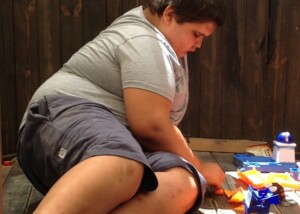Is an Obese Person Healthy Just Because They Exercise?

Exercise is great for any body, thin or obese.
But an obese person is NOT healthy just because she or he exercises.
One day on the “Dr. Drew” show, Jeannette DePatie, a NAAFA member who was leading exercise classes for the obese a that time, stated that fat people can be healthy as long as they focus on doing healthy things rather than on their size.
In the show she pointed out that the obese people in her aerobics exercise classes, over time, improved their mobility.
As a former personal trainer, I’ll agree that exercise improves ANYONE’s mobility — as I saw this occur with my clients who had compromised mobility.
This includes an obese older woman who had painful osteoarthritis in her knees.
According to DePatie’s reasoning, a smoker or heavy drinker can become “healthy” by taking aerobics classes.
Certainly, their mobility and stamina will improve, but unfortunately, the dangerous effects of smoking and drinking will still occur to the organs.
Obesity, too, has a negative effect on the organs, namely the heart.
Obesity Is an Independent Risk Factor for Disease

Shutterstock/Motortion Films
“Exercise can certainly help an obese person — it can improve heart health and keep a person more limber,” says Susan L. Besser, MD, with Mercy Medical Center, Baltimore, and Diplomate American Board of Obesity Medicine and board certified by the American Board of Family Medicine.
“But it doesn’t do anything about the long-term negative effects of the obesity — like damage to the internal organs (heart, liver, lungs, pancreas and so on) or damage to the joints from the added stress of having to move all that extra weight.
“Bottom line — certainly exercise, but work on losing the weight too.”
Let us not equate the term “better health” with “healthy.” They are not one and the same. They have two different meanings.
Exercise classes, gym workouts, walking and eating healthier will not undo the intrinsic hazards that obesity inflicts on the body if the fat remains.
The organs will still suffer, even if a 300 pound woman has hired a personal trainer and is now doing the battle rope exercise.
The hope is that her new exercise regimen and better eating habits will result in at least a 120 pound weight loss.
She should not become content with her 300 pound body just because she’s doing box squats combined with an overhead dumbbell press.
- The only way to undo the effects of obesity is to lose excess body fat.
- Therefore, the individual absolutely must focus on losing fat.
I’d like to see more obese men and women working out in the gym, particularly in the free weight area.
But don’t let regular exercise sessions make you complacent about your plus-size body, either.
An obese man or woman STILL needs to lose weight, even if they’re hitting the gym seven days a week — even if your “numbers” are normal.
A UCLA study that analyzed over 136,000 patients (American Heart Journal, Jan. 2009) noted that 75 percent of people hospitalized for heart attack had a normal cholesterol profile.
Often, obese people cite their normal blood numbers as proof they are healthy.
There are many risk factors for heart disease. Obesity is one of them. Exercise does not cancel out the risk-factor nature of excessive body fat when it comes to heart and other organ health.
 Dr. Besser provides comprehensive family care, treating common and acute primary conditions like diabetes and hypertension. Her ongoing approach allows her the opportunity to provide accurate and critical diagnoses of more complex conditions and disorders.
Dr. Besser provides comprehensive family care, treating common and acute primary conditions like diabetes and hypertension. Her ongoing approach allows her the opportunity to provide accurate and critical diagnoses of more complex conditions and disorders.
 Lorra Garrick is a former personal trainer certified through the American Council on Exercise. At Bally Total Fitness she trained women and men of all ages for fat loss, muscle building, fitness and improved health.
Lorra Garrick is a former personal trainer certified through the American Council on Exercise. At Bally Total Fitness she trained women and men of all ages for fat loss, muscle building, fitness and improved health.
.
Top image: Shutterstock/Pressmaster.
Sources:
sciencedaily.com/releases/2009/01/090112130653.htm
heart.org/HEARTORG/GettingHealthy/WeightManagement/Obesity/Obesity-Information_UCM_307908_Article.jsp
Cause of Eating Too Much: Fewer Brain Pleasure Receptors

Wow, could it be true, that something called “pleasure receptors” could be a leading cause of eating too much, of downing a whole box of donuts or quart of ice cream in one sitting?
So what’s causing you to overeat besides boredom, stress and delicious food?
The cause of overeating may be fewer pleasure receptors in your brain … according to Eric Stice, a senior scientist at the Oregon Research Institute, and a senior research fellow at the University of Texas. The study report is in the Journal of Neuroscience (2010).
Here’s what happens when you eat: More dopamine is released. Dopamine is a neurotransmitter in the brain.
The pleasure you get from eating your favorite foods is directly proportional to the quantity of dopamine that’s released.
Obese individuals, when compared to lighter-weight people, have a smaller number of dopamine receptors.
This suggests that the obese person will overeat to compensate for this smaller number of dopamine receptors.
The obese person will need to eat more, to get the same pleasure or satisfaction from eating, while slimmer individuals will need to eat less food to get the same rewarding response of satiation.
But the problem doesn’t stop there. In the obese person, the overeating to reap that satisfaction gets amplified by the overeating!
Says Stice in the report: “The weakened responsivity of the reward circuitry increases the risk for future weight gain in a feed-forward manner. This may explain why obesity typically shows a chronic course and is resistant to treatment.”
Now, before you blow this off as a bunch of baloney, images of the brain seem to support this finding.
Solutions to the Brain Receptor Issue
“There are receptors in the brain that target eating behaviors such as the ‘hunger’ hormone (ghrelin, among others),” says Susan L. Besser, MD, with Mercy Medical Center, Baltimore; Diplomate, American Board of Obesity Medicine and board certified by the American Board of Family Medicine.
“These hormones help to regulate eating behaviors. There are pleasure receptors too, similar to receptors that contribute to cravings of other substances.
“So yes, these hormones and receptors do affect one’s eating behavior.
“By the way, there is research and now some medications that are used to block these receptors to reduce one’s cravings (an example of this would be Buproprion).
“Just like some people don’t have cravings for other substances — such as alcohol, drugs or tobacco — the same could be said about food cravings.
“Some people are just less susceptible to cravings. Does this mean they actually have more brain pleasure receptors? Possibly, but the research is very limited here (but ongoing).”
Other Causes of Overeating must Be Addressed
They are: stress, anxiety, boredom, social cues (being around other people who are eating; coworkers bringing in baked goods; spouse offering food), miscellaneous cues (TV, chatting on phone, smelling fresh baked goods at grocery store), upbringing (e.g., being rewarded or calmed with food) and poor health habits that trigger hunger, such as eating too much refined food, and inactivity.
Nevertheless, the functional magnetic resonance imaging that was used to measure brain responses in study subjects, can’t be ignored, either.
The participants were tracked for six months, and the imaging on their brains measured responses to a chocolate milkshake.
Those who gained weight showed much less activation in a key area of the brain (dorsal striatum) in response to the milkshake at the six-month follow-up, compared to their original brain scan, and relative to subjects who did not gain weight.
So if you think fewer dopamine receptors are causing you to overeat … re-examine your cues and triggers for overeating, and you’ll surely discover causes that are not related to hunger, though excess intake of refined foods can cause overeating by triggering hunger (white rice, anyone?).
A good trick to practice, if you find it difficult to control the urge to overeat, is to tell yourself ahead of time that you will absolutely stop eating when you realize you’re approaching satiation.
Satiation is when you still have room for more food, but your stomach no longer feels like it’s empty, and you no longer feel it’s time to eat.
Do not eat past the point of satiation, no matter how delicious the food is.
Remind yourself that you can store the food for later eating, when you’re hungry again.
Another trick is to remind yourself that the pleasure of eating is greatest when you’re hungry, not when you’re satiated, let alone full or stuffed.
 Dr. Besser provides comprehensive family care, treating common and acute primary conditions like diabetes and hypertension. Her ongoing approach allows her the opportunity to provide accurate and critical diagnoses of more complex conditions and disorders.
Dr. Besser provides comprehensive family care, treating common and acute primary conditions like diabetes and hypertension. Her ongoing approach allows her the opportunity to provide accurate and critical diagnoses of more complex conditions and disorders.
 Lorra Garrick is a former personal trainer certified through the American Council on Exercise. At Bally Total Fitness she trained women and men of all ages for fat loss, muscle building, fitness and improved health.
Lorra Garrick is a former personal trainer certified through the American Council on Exercise. At Bally Total Fitness she trained women and men of all ages for fat loss, muscle building, fitness and improved health.
Source: sciencedaily.com/releases/2009/07/090727102030.htm
Best Barbell Fat-Burning Routines for Killer Calorie Crushing

Barbells bust bodyfat!
But you need to know the best fat-smashing exercises with barbells and know HOW to do them properly for optimal results.
Barbell exercises that work more than one muscle group are excellent for fat burning.
Because more muscles are used, more calories are burned.
Why spend hours and hours working out using isolated moves like sit-ups when you can burn more fat in less time with these powerful barbell moves?
Fat Burning Benefits of the Barbell Deadlift

No other exercise works as many muscles as the deadlift.
With this one move you can shred calories as you work your hamstrings, quads, calves, glutes, core, and upper body — all in a single shot.
Get a Good Fat Burn by Doing Barbell Squats
Squats are considered an essential exercise because of their calorie burning potential.

Freepik
The weight from the barbell only adds to the effectiveness of this move.
Squats have a positive impact on major muscle groups and overall strength, and it’s just so superior when it comes to fat burning.
Proper form is very essential when doing a barbell squat.
The Bench Press Is Not Just for Building Muscle, but Great for Fat Burning
When many think of the bench press, they picture sweaty, buff bodybuilders in a masculine-looking environment, but the bench press is for everyone.

Shutterstock/Nomad_Soul
If you’re interested in getting rid of some stubborn blubber, then the bench press is a must-have move.
Barbell Overhead Press: Standing Version
When you use a barbell to do the overhead press when standing, many muscles become engaged. This is a move highly effective in upper body muscle development as well as fat burning.

Discover the Fat Burning Action of the Bent-Over Barbell Row

Shutterstock/Catalin Petolea
Bent-over barbell rows engage the lower body, as you use it to keep yourself stable while performing the move.
This exercise also works the chest, biceps, back, plus your core.
As with all forms of lifting weights, proper form is essential.
If you use these five fat burning barbell exercises, the results will amaze you!
 Lorra Garrick is a former personal trainer certified through the American Council on Exercise. At Bally Total Fitness she trained women and men of all ages for fat loss, muscle building, fitness and improved health.
Lorra Garrick is a former personal trainer certified through the American Council on Exercise. At Bally Total Fitness she trained women and men of all ages for fat loss, muscle building, fitness and improved health.
.
Top image: Freepick.com/lyashenko
How to Make Jogging Burn Fat, Not Muscle

Never mind those images of sickly-looking marathon runners; you CAN make jogging burn all the fat you want–by using a particular technique known as HIIT.
HIIT stands for high intensity interval training.
As a result of its simplicity and basic nature, you might despise jogging as a useless technique when it comes to losing weight.
To reap the full benefits of jogging, mastering the right form, while keeping in mind the following factors is paramount:
Warm-up: You’re highly likely to ignore this stage, since jogging itself might appear as a warm-up exercise.
Walk for five minutes, then stretch for a few minutes before you begin jogging.
Warming up also ensures that your cardiac system is well prepared to enhance your heart rate and improve your blood flow. The warm-up session ideally should not exceed 15 minutes.
After the warm-up, it’s time to begin HIIT.
You should practice diaphragm breathing, rather than breathing from the upper part of your chest, for this increases oxygen flow.
HIIT means brief (15-30 seconds) bursts of your fastest running or jogging, relative to the course you’re on.
So if you’re slowly trotting up an inclining trail, you won’t be outright sprinting it during a 15-30 second burst, but it will be your best “sprint” relative to the incline.
If the course is flat or you’re on a treadmill at zero incline, it will be more like a sprint you’ll do. If you’re on a treadmill, DO NOT HOLD ON.
When it comes to exhalation, use your mouth as much as possible. This ensures that you release as much heat as possible from your system.
After knocking yourself out or nearly doing so with the burst, slow to a very slow trot–very easygoing, maybe even a walk–and do this for two to four minutes to fully recharge you for the next brief burst.
Can you make it to eight bursts? Eight bursts total should amount to no more than four minutes of your hardest work.
But even after just four truly butt-busting bursts, you will begin feeling pretty worked over. Try to complete eight. Take five minutes between burst intervals if necessary.
This is how to make jogging burn fat: HIIT.
Post-workout stretching: To get rid of waste byproducts in your muscles faster, don’t ignore this step. Stretches should be as gentle as possible to allow your body to cool off and relax your muscles.
HIIT is superior to “steady state” jogging for burning fat.
 Lorra Garrick is a former personal trainer certified through the American Council on Exercise. At Bally Total Fitness she trained women and men of all ages for fat loss, muscle building, fitness and improved health.
Lorra Garrick is a former personal trainer certified through the American Council on Exercise. At Bally Total Fitness she trained women and men of all ages for fat loss, muscle building, fitness and improved health.
Leg Press Machine Fat-Burning Technique: Bottom Half Reps

There’s a real ruthless way to burn fat with the leg press machine: bottom-half incomplete repetitions.
Partial reps on the leg press machine when done deeply will burn fat and strengthen the legs when done according to the following instructions.
Lower the sled as deeply as possible without letting the lower back lose contact with the seat.
The knees should not rest on the chest. To avoid the problem of the chest getting in the way, place feet far apart, and keep knees tracking over the feet; don’t let the knees buckle inward.
Now you can lower the sled deeply, knees on either side of your chest. Press back up but stop when your legs are a little past a 90 degree bend, maybe around 100 or 110 degrees. Then lower.
Each repetition never goes beyond a 110 degree angle at the knee. Thus, the “top” of the movement is actually what would be the “bottom” of the movement for the way most people do this exercise.
Most people lower the sled to halfway (or a little more), then press back up, sometimes nearly locking their legs out straight. Thus, the “bottom” part of the movement is the 90-110 degree bend.
If you make the bottom part right where your chest is between your knees because of the deepness of the eccentric portion, and then press up to make the “top” part the 90-110 degree angle, this will subject your legs to significantly more tension, and it can be quite brutal!
Keep feet flat on the sled; never push with the balls. The trick is to figure out what load incurs a raging burn within 10-12 reps.
You may inadvertently select a load, initially, that’s too heavy and find you can’t go past three reps.
Don’t be surprised; this leg press partial rep technique requires a much lighter load than the more common way of pressing, which I just described.
Find that sweet spot: the load range that lashes your legs with fire within 10-12 reps. Take a 45 second rest, then repeat.
Do six sets total with 45 seconds in between. You’ll probably need to decrease the reps by the third or fourth set.
At the end of the six sets, there should be a film of sweat on your legs, even arms.
The load should be such that it’s a major struggle to get through this routine.
Though the weight load is much lighter, this technique will develop strength, not to mention burn fat like mad due to the intense time under tension.
Summary of Partial Repetition Leg Press Workout
Six sets, 45 seconds in between, 8-12 rep max (give or take), partial reps: a serious fat burner and leg shaper that beats anything in a bottle.
You’ll never go back to going through the motions ever again.
 Lorra Garrick is a former personal trainer certified by the American Council on Exercise. At Bally Total Fitness she trained clients of all ages for fat loss, muscle building, fitness and improved health.
Lorra Garrick is a former personal trainer certified by the American Council on Exercise. At Bally Total Fitness she trained clients of all ages for fat loss, muscle building, fitness and improved health.
.
Top image: Shutterstock/Aleksey Boyko
10 Pound Dumbbell Fat-Crushing Exercises

It’s amazing how much fat a 10 pound dumbbell routine can obliterate.
You can base an entire workout on just two 10 pound dumbbells and burn a lot of fat.
The following workouts with just 10 pound dumbbells are not geared towards endurance.
This isn’t about walking while holding these little weights or curling them while pedaling a stationary bike.
This is about getting sweaty and huffing and puffing, getting hot and drippy with heart-pumping fatigue.
The objective is to fatigue rapidly for optimal fat-burning, but even if you’re already lean, these workouts will promote musculoskeletal and cardiorespiratory fitness.
Legs
Half-ball squat. Standing on the flat side of a half-ball, holding the 10 pounders at shoulder height or crossed at the chest, squat deeply for 20-30 repetitions.

Freepik.com
If you’re a beginner, squat on the floor for several weeks before moving on to the BOSU ball. Either way, rest one minute and repeat two more times with a minute rest.
Squats on the BOSU ball with the flat side up are more challenging.
Stool jump. Use a 12 inch stool and hold the dumbbells on either side of the body, and jump up with both feet at the same time, then jump back down.
The jump back down can also be forward. Jump as high as possible off the stool.

This is to be done as fast and as high as possible for one minute. Less fit trainees can jump onto a step class stepper elevated at one riser level.
Treadmill incline. Set treadmill to 15 percent and 2 mph and walk while holding the 10 pound dumbbells at the sides or at chest, for three minutes.

Shutterstock/Microgen
Depending on your fitness level, use a speed of 2.5 or even 3 mph, or if you’re not very fit, set the speed at 1.5 mph.
Squat jump. For 30 seconds, do your best squat jumps while holding the 10 pound dumbbells.

Freepik.com, cookie_studio
Don’t avoid the squat; get down as deep as you can before springing back up. Jump off the floor; don’t just go up on the balls of your feet.
Realize that the deeper the squat and higher the jump, the fewer repetitions will be completed in 30 seconds. The point is to become exhausted in 30 seconds.
Upper Body
Pushup-row-mountain climber. Get into a pushup position, hands on the 10 pound dumbbells.

Perform one pushup, row a dumbbell to your side with the right arm; do a pushup; repeat the row with the left arm; do a pushup; bring right knee to left abdomen, then left knee to right abdomen, then begin the sequence all over. Keep doing this for one minute.
If you’re not fit enough to do this, modify the routine. This can be done several ways.
For example, the rowing can be done by each arm before each pushup; or, the mountain climbers can be done in an alternating fashion instead of both legs successively; or, the pushups can be done off the knees.
Dumbbell swing. This is the same as the kettlebell swing except in each hand is the 10 pound dumbbell.
Swing them between the legs, breaking the plane of the legs, before swinging them back up, and swing them up above shoulder height. Do 15 to 30 reps, rest one minute, then do 15 to 30 reps.
Dumbbell jog. If the gym has a track, jog nonstop while holding the weights for five minutes as a semi-warm-down.
The final warm-down is a five minute walk holding the weights (or, to put it another way, a five-minute very light farmer’s walk).
If the gym doesn’t have a track, use the basketball court perimeter if it’s clear enough. If there isn’t a basketball court, use a treadmill.
How much rest in between each exercise?
That can vary, depending on one’s fitness level. It can be two minutes or one minute, or even 30 seconds for very fit trainees.
However, for the fittest people, have each station set up in close proximity, and move from one station to the next as each station is completed.
This can be thought of as a gigantic superset. In order to do this, though, intensity level of each component exercise must be reduced.
This workout is a total fat-burning enterprise, even though you’re using only 10 pound dumbbells.
Follow these instructions so that you get dripping, hot and out of breath for optimal burning of stubborn body fat.
 Lorra Garrick has been covering medical, fitness and cybersecurity topics for many years, having written thousands of articles for print magazines and websites, including as a ghostwriter. She’s also a former ACE-certified personal trainer.
Lorra Garrick has been covering medical, fitness and cybersecurity topics for many years, having written thousands of articles for print magazines and websites, including as a ghostwriter. She’s also a former ACE-certified personal trainer.
.
Top image: ©Lorra Garrick
Can Stress and Anxiety Shorten Telomere Length?

The last thing you want to happen to your cells’ telomeres is shortening!
If you’re under chronic stress and anxiety, your telomeres are probably getting clipped.
A study (Effros, 2008) and published in Brain, Behavior and Immunity has discovered the mechanism by which stress ages the body and lowers its resistance to severe illness.
It is normal for the body to release stress hormones when in stressful situations, but when this condition persists and the stress hormones such as cortisol are present in the bloodstream for a prolonged period of time, they can lead to shorter telomere length and damage the ability of the body’s cells to divide.
Stress Shortens Telomere Length
The cell’s ability to divide is key to preserving young and active cells in the immune system.
This ability is governed by the length of telomeres, which are located at the tips of chromosomes.
Telomeres naturally shorten every time a cell divides.
Cell division ceases when telomeres become too short or nub-like.
When a person is under stress, cortisol is produced and released into the bloodstream.
The study, authored by Professor Rita Effros of the David Geffen School of Medicine at UCLA, shows that cortisol hinders an immune-system cell’s ability to use telomerase (an enzyme) to preserve telomere length.
People under chronic stress have shorter telomeres and therefore less active immune systems.
Can you stop your telomeres from shortening due to emotional stressors?
“Telomeres shorten as we age — and yes, stress and anxiety can hasten this shortening,” says Rupali Chadha, MD, former chief of medical staff at Metropolitan State Hospital in Norwalk, CA.
“And even if one cannot escape a stressful situation, oftentimes it is possible to reframe how we view our role in it.
“Easier said and not often always possible. But it might mean the difference to your mental state and telomeres.”
The stress and anxiety of an hour of driving to and from work each day, emotional tensions at home or work, illness of a loved one, or any similar situation is enough to cause elevated cortisol levels.
To combat stress, you may want to commit to visiting a gym straight after work instead of “unwinding” at a bar. A hard workout helps lower cortisol levels.
Another tactic is to choose your battles wisely. Is it really worth it to get all worked up because your tween daughter wants to put purple streaks in her hair?
 In addition to general psychiatry, Dr. Chadha is also a forensic psychiatrist who treats the brain conditions of the criminally insane and serves as an expert witness in trials. She has a passion for fitness plus how the body, mind and spirit come together to build a healthy individual.
In addition to general psychiatry, Dr. Chadha is also a forensic psychiatrist who treats the brain conditions of the criminally insane and serves as an expert witness in trials. She has a passion for fitness plus how the body, mind and spirit come together to build a healthy individual.
 Lorra Garrick has been covering medical, fitness and cybersecurity topics for many years, having written thousands of articles for print magazines and websites, including as a ghostwriter. She’s also a former ACE-certified personal trainer.
Lorra Garrick has been covering medical, fitness and cybersecurity topics for many years, having written thousands of articles for print magazines and websites, including as a ghostwriter. She’s also a former ACE-certified personal trainer.
Source:
University of California – Los Angeles (2008, July 16). Mechanism Behind Mind-body Connection Discovered. ScienceDaily. Retrieved July 22, 2008, from http://www.sciencedaily.com /releases/2008/07/080715152325.htm
Childhood Obesity & No Exercise: Which Starts the Cycle?
If the average obese child is sedentary, did the obesity cause the inactivity?
Or does being “lazy” cause the excess fat to pile up in a child’s body?
“This answer depends on the child,” says Dr. Lisa Lewis, MD, a board certified pediatrician in Fort Worth, Texas, and author of “Feed the Baby Hummus, Pediatrician-Backed Secrets from Cultures Around the World.”
“Many overweight children are very active,” continues Dr. Lewis. “Their weight does not hinder them from exercising.”
Obesity, or what a parent might see as plump, chunky, chubby or pudgy in their child, should never be an excuse for promoting lack of exercise or avoiding sports participation.
Though a heavy child won’t be breaking the tape in a sprint race, they can do pretty doggone well in martial arts, skating, hiking, and even aerobic activities like basketball, volleyball, soccer and tennis.
But Dr. Lewis says, “If they are eating the wrong foods, then even with intense exercise these children will remain obese.
“Some children are naturally sedentary and don’t enjoy exercise. If these children overeat or eat the wrong foods frequently, they have an increased risk of obesity.”
Exercise and the Obese Child’s Body
Maybe you’ve always thought that exercise would be difficult for overweight children.
And you’re partially correct. Certainly, running around the school track would be difficult for a sedentary overweight child.
But it’s also difficult for a thin sedentary adult.
Every body needs exercise.
Though it’s common sense that obesity will discourage physical activity in kids, there’s also research that shows this.
As time goes on, overweight children do less and less physical activity and increase sedentary behavior like TV or computer entertainment.
But what about kids of normal body weight who take to watching a lot of TV or computer use?
The study shows that this does not necessarily cause them to gain weight. But one study is not the gospel.
Increased sedentary behavior may burn fewer calories, BUT … it can also encourage more snacking, including drinking sugary sodas.
The journal, International Journey of Obesity, 2014, has the full report.
What makes this study unique is that it investigated the connection between childhood overweight and physical activity over time, whereas most other studies measure data from a single snapshot in time.

Freepik.com, jcomp
• The age of the children in this study was that of third and fourth grade, and consisted of 600 kids.
• For two occasions they were equipped with a special activity tracker, for seven days at a time: 1) at the beginning of the study, and 2) six months later.
• The tracker recorded activity around the clock, and was compared with data of fat mass at the start and end of the study.
• Children with the highest levels of body fat experienced the largest reduction in physical activity over the six month period.
Does this mean that being obese makes it difficult for these children to exercise or play sports?
Or does it mean that kids who’d rather sit around all day and overeat, in general don’t care to run around, jump and get winded — and as a result, over time they gain fat mass?
Though nobody will argue about the hardship of extended running on an obese body, this doesn’t explain, from a mechanical and cardiorespiratory perspective, why so many clinically obese children are very sedentary.
Physical Activity for Obese Kids May or May not Involve Running

Shutterstock/Natee K Jindakum
It could be karate, dancing, jumping on a trampoline, bike riding, extended walks, badminton and ping pong.
It could also come in the form of delegating some housework or yard work duties, to replace some TV and computer time.
This can add up over the long-term. Put your overweight child to work; he or she is part of the household too!
Just make sure that the work is age appropriate. A fat young child can rake leaves, sweep and pick things up off the floor.
Carrying loads of laundry, transferring washed clothes into the dryer and retrieving dried clothes from the dryer are also activities that a young child can perform.
Childhood obesity is no excuse for excessive TV and computer time.
Having 25+ years’ experience, Dr. Lewis completed her pediatrics residency at Texas A&M University Health Science Center, Scott and White Memorial Hospital. For two years afterward she was assistant professor in the department of pediatrics at Texas A&M University Health Science Center.
 Lorra Garrick has been covering medical, fitness and cybersecurity topics for many years, having written thousands of articles for print magazines and websites, including as a ghostwriter. She’s also a former ACE-certified personal trainer.
Lorra Garrick has been covering medical, fitness and cybersecurity topics for many years, having written thousands of articles for print magazines and websites, including as a ghostwriter. She’s also a former ACE-certified personal trainer.
.
Top image: Shutterstock/Yuriy Golub
Source: sciencedaily.com/releases/2014/01/140122091619.htm
Why the Morbidly Obese Should Not Hold Onto a Treadmill

Are you morbidly obese and hold onto the treadmill for your walks? Stop doing this. It will sabotage your efforts to lose weight. (more…)
When Ribs Showing Above Breasts Mean You’re Healthy





































































